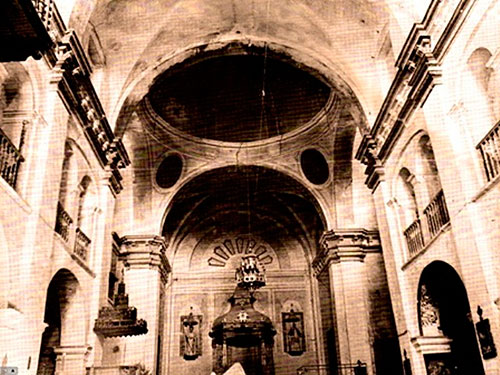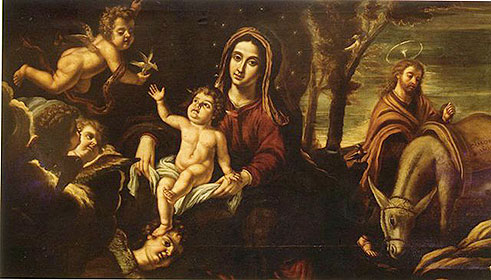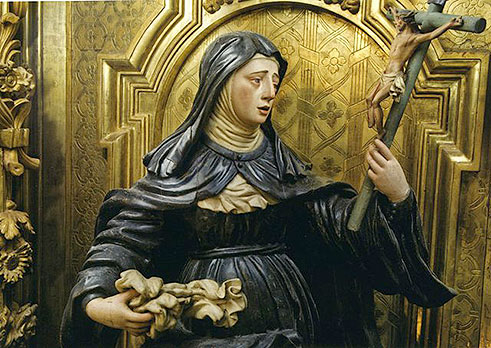BRINGING HERITAGE CLOSER. CORELLA
24 August 2010
Corella in the culture and art of the Baroque period
D. Ricardo Fernández Gracia. Chair of Heritage and Navarrese Art.
If anything characterized the arts in Corella in the centuries of the Baroque was the character of authentic receiver and transmitter focus. Throughout the XVII and XVIII centuries, masters of different specialties and coming from different places of the peninsular geography settled in the locality of Corella that had obtained the degree scroll of city in 1630. Likewise, pieces of movable art imported from the Court, Italy and American lands together with drawn architectural projects arrived throughout the two centuries, enriching the artistic environment of the whole region. The same can be said of the expansion of the workshops established there, especially among some master builders such as Pedro Aguirre or Juan Antonio Jiménez who worked on works outside Navarre, some as significant as the palace of the Marquis of Casatorre in Igea in La Rioja. The presence of an active guild of carpenters and masons who had their own chapel in the parish of San Miguel, under the patronage of the Desposorios, is also significant. The confraternity dates from 1645 and the primitive altar consisted of a canvas. Later, between 1729 and 1732, the current altarpiece was erected by Domingo Romero, Martín de Tovar and the painter José Roldán.
A consideration that must be taken into account when analyzing the cultural assets of those centuries is that the Baroque is something more than all these manifestations, since it constitutes a whole culture impregnated in the bowels of the Ancient Regime that participates in the general characteristics of European art, but which in turn presents innumerable peculiarities within the Hispanic context.
The city, thanks to outstanding and emerging lineages studied by Arrese and with the push of some institutions, was enriched with outstanding palaces, convents and churches that displayed in their interiors rich furniture, paintings and objects of sumptuary pieces of different origins. It should be noted that although we know the ecclesiastical patrimony very well, the same is not true of the contents of the great mansions, even if only from the documentary point of view.
It goes without saying that the arts in the city participated in everything that characterizes the culture and particularly its formal characteristics: pictorial art, with a taste for movement, magnificence, the employment and the handling of light skillfully..... and, of course, based on sensory impact (attracts, dazzles....), grandiloquence, ornament, excess, extravagance, draperies that conceal ... etc.. The altarpieces of the churches, the scenographic staircases of the stately homes, the paintings and the small works of sumptuary arts of the period were intended to move, impress, enervate and, in final, to sensorially provoke the individual, marking behaviors through the senses, much more vulnerable than the intellect. In final, both with material goods and with everything that today we call intangible heritage, the aim was, by all means, to awaken and move the affections: the great reason for the Baroque.
Some decades ago, in a documented monograph on religious art in the town by José Luis Arrese, he pointed out in a paragraph of the prologue some ideas that even today, in times of globalization, are still valid. There he affirms: "Because Corella, and let us affirm once and for all and without distinction, Corella is a baroque city; in the art, in the landscape, in the character of its neighbors and even in the unusual waste of popular energies. Corella, like the Baroque, is a lie to the naked lesson of the rule and an applause to the delirious concept of form: One speaks loudly in the street, because one is baroque; one likes noise at parties, because one is baroque; one rings the bells with din and profusion, because one is baroque, and one runs and plays before the horns of a bull, because one is baroque. Only by being baroque can one perform the "quitar a la muerte", the unnecessary "cara o cruz" of the running of the bulls, without anyone taking it as suicide".

Former church of the disappeared convent of La Merced in Corella.

Rest of the Holy Family. Sebastián García Camacho, 1704. Church of San Miguel de Corella

Saint Monica. High altarpiece of the church of San Miguel de Corella. Juan Antonio Gutiérrez. 1718-1722
PROGRAM
Tuesday, 24th August
Milestones in the History of Corella
D. Esteban Orta Rubio. Society of Historical Studies of Navarre
Writers and publicists of Baroque Corella
Mr. Javier Itúrbide Díaz. Uned of Tudela
Corella in the culture and art of the Baroque period
D. Ricardo Fernández Gracia. Chair of Heritage and Art of Navarre
Wednesday, 25th August
The hidden Corella. Behind the lattices of the city's enclosures
D. Ricardo Fernández Gracia. Chair of Navarrese Heritage and Art
The sumptuary arts: at the service of the splendour of worship and the Liturgy
D. Ignacio Miguéliz Valcarlos. Chair of Navarrese Heritage and Art
The festive calendar
D. Francisco J. Alfaro Pérez. University of Zaragoza
visit to the church of San Miguel
visit to the tunnels
Thursday, 26th August
A look at architecture and the arts in Corella in the 19th and 20th centuries
José Javier Azanza López. Chair of Navarrese Heritage and Art
The image of the Rosary and Saint Michael in the arts
Ms. Mª Gabriela Torres Olleta. GRISO. University of Navarra
Corella, conventual and palatial city: visit guided tour
Ms. Pilar Andueza Unanua. Chair of Navarrese Heritage and Art
Closing

